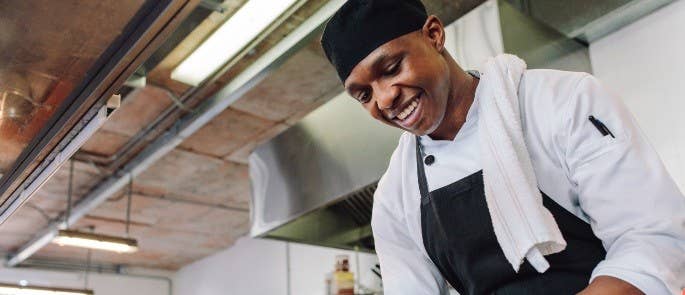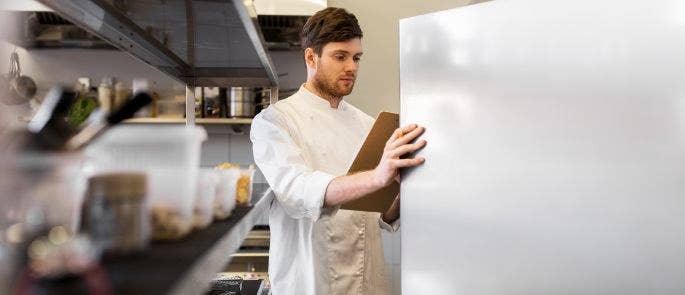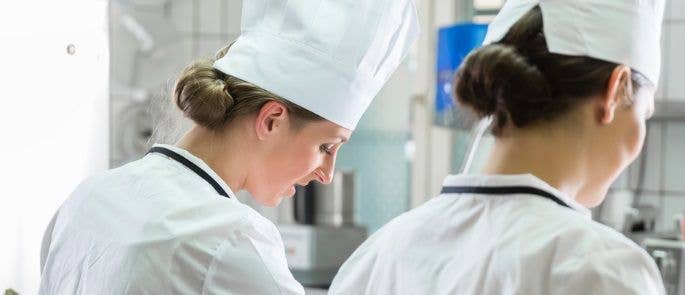What’s the Importance of a Chef Uniform in Hospitality?
Many workplaces choose to adopt a staff uniform, including retail, healthcare, and manufacturing environments. Even those workplaces that don’t follow a strict uniform still tend to provide some guidance on a suitable dress code. For example, asking for a ‘professional’ attire in education and office environments.
In the hospitality industry, wearing a uniform is particularly important and beneficial for both staff and customers alike. For front of house staff, wearing a uniform makes them easily identifiable and maintains a professional image. For staff who are more behind the scenes, like chefs, the uniform is important for health, safety, and hygiene. If you work in hospitality, it’s important that you wear the correct uniform and understand why you should.
Why Is It Important for Chefs to Wear Uniform?
Under food hygiene law, including the Food Safety Act 1990, anyone who works with food has a responsibility to ensure that the food they prepare is safe. While this does mean that food should be stored and prepared safely, it also means that you need to understand the importance of wearing a chef uniform in order to uphold the safety of food. In fact, there are three main reasons why chefs should wear uniform:
Food Hygiene
Wearing the appropriate uniform is just one positive step you can take towards ensuring food safety. Chefs must wear the correct protective clothing in food areas at all times, as this will help to ensure that any contaminants carried on normal clothing, such as pet hairs or dirt, do not contaminate the food.
As well as wearing their whites, chefs must also wear the appropriate hair coverings whilst in food preparation areas. For example, wearing hats to cover hair and beard snoods to cover any facial hair will help to prevent hairs from falling into food. What’s more, when abiding by other uniform requirements, such as not wearing jewellery to work, you will help to prevent further contamination. For example, you will prevent any bacteria that may be caught in the crevices of jewellery, or any physical stones that may fall from the jewellery, from coming into contact with the food. In turn, this will lead to safer food and benefits including happier customers and a better business reputation.

Personal Comfort
Multiple ovens, hobs, and other heating equipment undoubtedly make commercial kitchens hot environments. For chefs, the heat can become very uncomfortable, especially if they are working a long shift. Therefore, wearing the appropriate uniform is crucial for personal comfort.
To be comfortable and remain cool, chefs should wear uniform that is the appropriate size for them and still has room to allow airflow and breathability. It should be made of a comfortable material and not irritate the skin during use. Chefs must tell somebody if their uniform is uncomfortable or ill-fitting, as this will affect their comfort, work ability, and performance in the long run.
Professionalism
While chef uniform is important for the safety of food as well as staff comfort, it also has a purpose in terms of appearances. You may have an open kitchen in your restaurant where people can see their food being prepared, or it may be the case that the chefs at your establishment aren’t generally seen by the public. However, whichever one of these it is, there’s no doubt that chef uniform gives an appearance of professionalism. If a customer notices a chef wearing their own clothes, they may have questions about how safe the food is that they’re preparing.
Additionally, there are benefits if employees wear uniform outside of the kitchen, including your front of house staff. Customers will be able to identify your staff quicker, resulting in reduced waiting times, quicker and better customer service, and overall happier customers.
What are the Different Components of a Chef Uniform?
There are many different components of a chef uniform, each of which plays an important part. Each piece of uniform has a specific purpose, from protecting food from contamination all the way to denoting seniority in the chef hierarchy.
The different components of chef uniform include:
The Jacket
This has multiple different features that all contribute to its functionality and practicality. The jacket is usually double-breasted as this provides an additional layer of protection from heat or any hot splashes. The material is often made from a heavy cotton or a polyester and cotton mix as this allows breathability and also helps to protect the chef from any hot splashes. The jacket is traditionally white as this makes stains more easily identifiable, which helps to uphold hygiene. The crisp white jacket also gives a professional and clean look.
Finally, the jacket should contain some sort of mechanism for fastening it up. This can either be Velcro or stud buttons. Both Velcro and stud buttons provide the ability to remove the jacket quickly in case of an emergency. The stud buttons are generally very low-risk, as the possibility of them falling off and into food is much lower than other fastening mechanisms.

The Pants
Like the chef jacket, chef pants help to prevent contaminants from everyday clothes from contaminating the food. They are also loose fitting to assist with movement and breathability and are made from a thick material to help minimise the dangers from hot spills.
Traditionally, chef pants are designed to have a black and white checked pattern, although some chefs are now opting for trousers with a plainer design.
The Apron
Whilst it isn’t considered a part of a traditional chef’s uniform, many chefs are choosing to wear an apron over their whites when they’re in the kitchen. An apron provides an added layer of protection against heat and flames, as well as stains.
Aprons should be made of a flame-retardant material and must be tied and fitted correctly. This will help to prevent any loose parts from being dipped into food or coming into contact with open fire.
The Shoes
Chefs stand on their feet for hours at a time, so having comfortable shoes is key. For comfort, shoes must be well fitted and have good shock absorption. This will relieve some of the pressure on the bottom of the feet from standing on the hard floor.
For safety, all chefs should wear shoes that are non-slip and have steel or reinforced toecaps. This will limit the risk of injury in case they drop any heavy equipment or hot liquids. Additionally, although not compulsory, many chefs wear shoes without laces to limit the risk of tripping over an untied lace.

The Hat
The hat, or the toque blanche to use its traditional French name, is a well-recognised component of a chef’s uniform. However, a lot of chefs choose not to wear the classic high hat anymore. Historically, the wearing of the toque blanche indicated the status of a chef in the kitchen. The higher the chef’s hat was, the more senior they were. Furthermore, the number of pleats on the hat represented the number of recipes that the chef had mastered.
Now, many chefs choose head-wear that’s a little less extravagant, including smaller hats, skull caps, and bandanas. Some even opt for disposable food service hats or hairnets to protect their heads, and the safety of food, instead. The requirements for the type of head-wear depend on each individual restaurant requirement. Some high-end fine dining restaurants still choose the toque to signify quality and the level of establishment.
It’s essential to understand the importance of a chef uniform as it not only benefits food safety, but is also beneficial for personal safety, comfort, and professionalism. Wearing uniform in hospitality has many benefits for both front and back of house staff and cannot be ignored.
What to Read Next:
- What Skills Do You Need To Be a Chef?
- Managing Mental Health & Wellbeing in Hospitality
- Is There a Difference Between a Chef and a Cook?
- Online Food Hygiene Training







